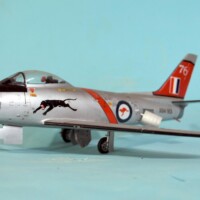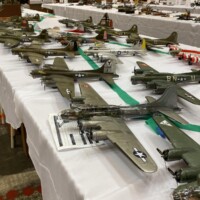Yet Another Sabre from the Garage of Doom – 1/48 CAC Avon Sabre Mk. 31 Red Roo conversion
Australia's first jet fighter was the DeHavilland Vampire, built under license by Commonwealth Aircraft in 1948-49. The follow-on possibilities included the Grumman Panther and the Hawker P.1081, a project which never went past the prototype. The advent of the Korean War brought the acquisition of the Gloster Meteor F.8 as an interim type. RAAF pilots in Korea soon learned that the Meteor was completely outclassed by the MiG-15, and began a campaign to acquire the North American F-86 Sabre.
The Australian government signed an agreement with North American on February 22, 1951 for license production of the Sabre. For economic reasons, the RAAF had to insure that its equipment would remain effective well into the 1960s. This meant that the RAAF Sabre needed more modern armament than the World War II era six .50 caliber machine guns, and an uprated powerplant for improved performance. The 30mm Aden cannon was chosen for the new armament, and the Rolls-Royce Avon RA-7 engine became the new power plant, with an increase from the 6,100 lbs of thrust of the G.E. J-47 to 7,500 lbs of thrust with the Avon.
The change in powerplant required a redesign of the Sabre's fuselage to cater to the increased airflow requirement of the Avon, and to the fact that the engine was 500 lbs lighter than the J-47, requiring that it be re-positioned further aft. The intake was deepened 3.5 inches, and the fuselage "break" was re-positioned. The redesign involved changing 60 percent of the original fuselage structure. The end result was the most formidable Sabre of all.
The prototype flew August 3, 1953, with the first production Sabre delivered July 13, 1954. The Sabre attained IOC with the RAF on March 1, 1956, when the Mk.30 fully equipped 3 Squadron. The Mk.30 used the slatted wing. In 1957, the slats were reoved and replaced with the “6-3" "hard" wing of the F-86F, their designation changing to Sabre Mk. 31. The Mk.32 introduced the Sidewinder missile for increased armament.
The Australian Sabre entered combat in operations against the terrorists in Malaya in 1958. From 1958 to 1960, CAC Sabres of No. 78 Wing RAAF (78 Wing), comprising 3 Squadron and 77 Squadron, undertook several ground attack sorties against communist insurgents in the Federation of Malaya, during the Malayan Emergency. Following the Emergency, they remained in Malaysia at RAAF Butterworth). Sabre Mk. 32s armed with Sidewinder missiles were responsible for regional air defence during the Konfrontasi between Indonesia and Malaysia from 1963 until 1966, though no combat took place. Between October and December 1965, a detachment of six Sabres, initially from 77 Sqn and later from 3 Sqn, was based at Labuan to conduct combat patrols over the Indonesian–Malaysian border on Borneo.
Sabres were also sent to Thailand in 1962, remaining there until 1968 as airfield defense during the buildup of operations around the Vietnam war. Many USAF officers believed the Australian Sabre would have been the best escort fighter against the NVAF MiG-17 that formed the majority of the aerial opposition during this period.
When Robin Olds took command of the 8th TFW in 1967, he instituted a program to teach the wing’s pilots Air Combat Maenvering, something only he, Vermont Garrison and Chappie James knew. The RAAF’s 79 Squadron was providing airfield cover, and Olds worked a deal with the Australians that they would fly as “aggressors” for training the Wolfpack F-4s. Since the Australian pilots were all experienced in ACM, they enthusiastically attacked F-4s at every opportunity. Ralph Wetterhahn, who flew “Olds 2" as Olds’ wingman, later recalled that the experience that was gained during the six weeks of informal training Olds instituted with the RAAF was crucial to the Wolfpack’s later air combat success over North Vietnam.
Following the Sabre's withdrawal from first line service with the RAAF, they were supplied to the Royal Malaysian Air Force commencing in 1969.
Red Roo's conversion kit for the Sabre was originally designed to be used with the Hasegawa kit, though it can also be used with some modifications on the Academy Sabre. The kit includes fuselage halves, nose intake, enlarged intake trunk, and lower rear fuselage plate for the modifications. The lower rear plate is used only on the Academy conversion. The Hasegawa kit to use is the F-86F-30 model.
Construction begins by sanding out the interior of the forward fuselage of the Red Roo set, since it is thicker than the Hasegawa parts it replaces. Without doing this, nothing will fit.
Next, cut and trim the intake trunking and replace the section of the Hasegawa kit with the Red Roo part. When you fit the Hasegawa nose wheel well to the Red Roo kit, you will need to trim the Red Roo parts to fit with this, but there is nothing difficult here.
I built this kit using the Hasegawa cockpit, with a KMC ejection seat. The cockpit of the Australian Sabre differs from the US version in small ways, the most prominent being the difference in the way the instrument panel is attached. Without photos of the cockpit of the Avon Sabre, I am not sure I actually got this right, but I also know there is a small chance anyone here in North America will know enough about the Australian version to catch this when looking at the model. I decided that I would do this with the canopy closed, since the canopy (once dipped in Future) is so clear.
I test-fitted the parts to go inside the Red Roo fuselage, and found I needed to sand it thinner. Once I had, everything fit easily, and I glued the fuselage together and attached the wings. These parts, being limited-run, do not fit as closely as the Hasegawa parts, and I needed both putty and Mr. Surfacer to get rid of the seams. Once this was done, the model was looking good and was ready to paint. I did not choose to attach the pylons or use the drop tanks, since I wanted to do a "clean" airplane.
The Australian Sabres were painted overall with aluminum lacquer, rather than left in natural metal finish. The Red Roo instructions make a point of how smooth and satin-like this finish was. I used SnJ Aluminum paint for this. I then painted the nose and rudder Gunze Sanyo "Shine Red," the closest match I could find for the red shown in the kit decals for the version I was doing, then painted the anti-glare section with Tamiya Semi-Gloss Black. I finished off by painting the exhaust section and the panel around the cannons with Testors Model Master "Stainless Steel," then gave the model a coat of Future.
Red Roo provides decals for one Sabre from 3 Squadron, one from the 76 Squadron "Black Panthers" demonstration team, two from "The Marksmen" flight demonstration team, and three from the Royal Malaysian Air Force - one in aluminum lacquer and two in dark green/sky camouflage. I chose to do the "Black Panthers" aircraft.
The Red Roo decals went on perfectly and snugged down under MicroSol with no problems. The decal sheet includes all the stencils for the Australian airplane, with diagrams for each side of the fuselage showing placement. I used black stripe decals from the Decal Dungeon for the leading edges of the wings and tail surfaces, and the trim on the wingtips and vertical fin.
Unfortunately, the Red Roo conversion kit is long out of production, though kits appear for sale on the internet from time to time.















Excellent conversion, my friend @tcinla! Great that the model has withstood well the passage of time!
Another worthwhile save, Tom, and an interesting write-up.
Beautiful conversion, I like it a lot.
Again Tom I am humbled by your ability. Very nice job. I do believe you either have the entire series of Sabres, or are close.
Bruce
When oh when will someone please please please do a 1/48 F-86H?! 🙂
Great to see your F86 collection extended with this RAAF version, Tom @tcinla
Very nice work on this almost doomed kit.
Great article as well.
Gorgeous build with an exciting scheme! It looks just so elegant and beautiful.
Magnificent work on your Aussie Sabre. I really like it Tom.
Very nice work on this Sabre, Tom @tcinla! 👍 I wish SnJ was still available; my last bottle went bad before I could use it. 🥲 Man, it was good paint too!
It was indeed, Gary.
That is an outstanding conversion. Beautiful work as always. There's a lot of history herethati didn't know, that's why I allways look forward to seeing your builds and especially reading your articles, always top notch. Thanks, I look forward to the next one.
G’day Tom (@tcinla),
This is an aircraft I have wanted to build for the longest time. Unfortunately I’ve never come across the conversion.
The lab I used to work at had one as a gate guard for many years.
Unfortunately it was removed in 2008 due to excessive corrosion. ADF-serials.com.au has it in storage at the Point Cook museum.
I worked with a clerk who was ex-RAAF who told me of a fatal incident when someone he knew was once sucked into the intake during a ground run of the engine. This led to the development of a intake basket for use during engine ground runs.
Incidentally, Sabers were also supplied to Indonesia post service with the RAAF.
You have done your usual excellent build with this.
Liked!
Thanks @michaelt Red Roo should bring this one back.
Or maybe Eduard should do the whole family…
Yes!
Very nice result Tom. I'd forgotten all about SnJ, I used to use that a lot.
Beautiful Tom, one of my favorite A/C. Good write up as well
Nice work on the ultimate Sabre, Tom!
Nice save and well done as usual.
It looks like the Pineapple Express (River of rain from above) was great motivator for bringing these two ( articles) Sabre kits to the surface for a build. The weather extremes where experiencing in the states have been a mixed blessing. You can't go wrong with a F-86 Sabre as a crowd pleaser. The Avon powered F-86 done hear is a real treat. I think the ultimate Sabre is the F-86H armed with cannons and a up rated J73-GE-3E. When the U.S. was able to get there hands on a clandestine Mig-19 they used a F-86H as test a/c for fighting the Mig.
Another nice-looking Sabre! Keep them coming...